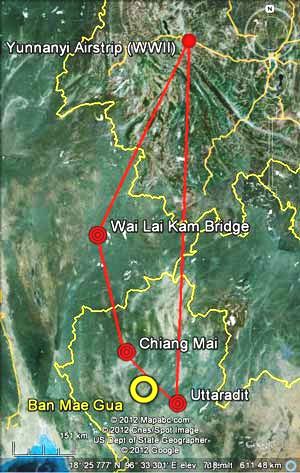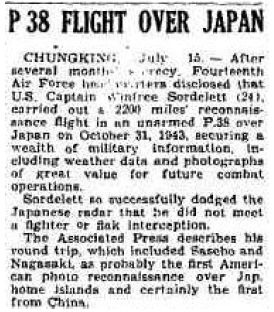| N17°57.1 E99°21.0 |
Ban Mae Kua (Th: บ้านแม่กัวะ / Jp: バンメイクア ) Crash Site Lampang Province page 2 of 2 |
Thai Route 0001 Sta 000.00 |
| Text | Notes | ||||||||||||||||||||||||||||||||||||||||||||||||||||||||
|
Range of a P-38 fitted for reconnaissance: more detail There appears to be a wide discrepancy between the range of a P-38 per standard references and McKinney's flight plan: Per the MCR, McKinney's P-38 had a type-model-series no, McKinney's flight The general location of the apparent crash site, Ban Mae Gua (with circle in yellow below) is consistent with McKinney's flight plan (traced in red below): Using these destinations:[36]
The flight's duration was speced for 1015 to 1715; ie, 7 hours. An average speed calculates as: 2021 km / 7 hours = 289 kph Thus, McKinney's average speed, at 156 knots, was only 60% of the P-38's speced 252 knot cruising speed; but his required range of 2021 km (1265 nm) far exceeded the speced 724 km (392 nm). It would seem improbable that the lower rate of fuel consumption resulting from a lower flight speed could free up enough fuel to allow the higher flight range required. Planned fuel consumption cannot be calculated: no information is available on how much he was allotted. Playing with the numbers Per Wikipedia: Lindbergh was instrumental in extending the range of the P-38 through improved throttle settings, or engine-leaning techniques, notably by reducing engine speed to 1,600 rpm, setting the carburetors for auto-lean and flying at 185 knots (342 km/h) indicated airspeed which reduced fuel consumption to 70 gal/h, about 2.6 nmpg.[38] Per The Aviation History Online Museum: An internal fuel capacity of 410 gallons could be increased to 1,010 gallons with two external drop tanks. Various conclusions: With the 2.6 nmpg figure resulting from Lindbergh's "engine-leaning techniques", the internal 410 gallon fuel capacity represented a potential range of 1,070 nm or close to 2000 km, which would have provided no safety margin for McKinney's 05 Nov 1944 assignment. However, the 1,010 gallon capacity, as supplemented by the drop tanks, represented a potential range of 2,626 mi or 4,850 km, more than twice the range required for his mission.[39] With the external tanks, but not using Lindbergh's range enhancement procedure, McKinney would have had a range of 2050 km (1100 nm)[40] --- again inadequate for McKinney's planned flight. With drop tanks installed, maximum cruising speed was reduced to 250 knots (460 km/h);[41] which would have been irrelevant in view of McKinney's need to observe fuel conservation. Sordelett's flight Dan Jackson describes an extreme example of just how far a P-38 fitted with drop tanks could go:[41a] Col Barrow said that the 1,000+ gallons of fuel would give them ten hours aloft. Remember that the F-5 was stripped down. It could fly higher and more efficiently than a normal P-38. This was demonstrated most notably by Capt Winfree[41b] Sordelett, from the 21st PRS, who in early 1944 flew an 11 hour and 40 minute mission from Suichuan, China,[41c] to photograph Nagasaki and Sasebo in southern Japan. He was so stiff from being crammed in the cockpit so long, he had to be lifted out. On 31 October 1943, Capt Winfree Sordelett flew a P-38 outfitted for photo reconnaissance over Japan:[42]
Col Barrow added detail via Dan Jackson: Sordelett, from the 21st PRS, took 11 hour 40 minutes to fly from Suichuan Airfield, China,[43] to photograph Nagasaki and Sasebo in southern Japan and return.[44]
Using these destinations:[45]
The flight's duration was speced for 11 hours 40 minutes. An average speed calculates as: 3516 km / 11.7 hours = 301 kph Assuming that the fuel capacity was 1010 gallons, the average fuel consumption was: (3516 km / 1.852 km / nm) / 1010 gallons = 1.9 nmpg As a footnote to that feat, he is recorded as having returned with "extra" fuel.[46a] Thus his actual rate of fuel consumption was less than the 1.9 nmpg calculated above. Conclusions The speed and range for Sordelett's flight, which occurred more than a year before McKinney's flight, generally confirm the expectations for McKinney's planned flight. And, if the RTAF report is valid: the time and location of McKinney's crash are precisely (and unsettling in that precision) consistent with his flight plan. Dan Jackson offered some hard-won knowledge; There's not a lot of great information about the specifications / capabilities of photo reconnaissance Lightnings out there. I couldn't even find consistent info on max speed and service ceiling. My information on range is from operational reports, such as the one detailing Sordelete's mission to Nagasaki. It's easier to say the plane could do 10+ hour missions when there are several reports detailing such performance as routine on missions.[47]
Aircraft are definitely vulnerable to lightning strikes. However, damage was never common: the last aircraft confirmed downed by a lightning strike was in 1967, with the cause found to be "catastrophic fuel tank explosion". Coincidentally, such an event would appear to have downed McKinney's plane. There have been no such incidents since 1967, but that is primarily because aircraft engineers now specifically address lightning strikes in their designs.[48]
|
35.^ Google Earth "Yunnanyi Airstrip", now Xiangyu Airport or Xiangyun Midu Air Base is located about 19 km ESE of present day Xiangcheng (see also TopoMapper dual view). "Wai Lai Kam Bridge", has apparently been replaced by the 4,000m long Kunhing Bridge, spanning the Nampan River, on the Taunggyi-Kengtung Road (Burma Route 4).
36.^ Coordinates sources: Yunnanyi Airfield
37.^ The "Total" distance makes no allowance for aerial photo flight patterns over the "targets". The "Adjusted total" distance adds 100 km per target.
38.^ Per The Lockheed P-38 - Specifications "Model Specifications Version: L", the range was 450 nm; with 410 gal internal fuel tanks, fuel consumption would have been 1.1 nmpg. Quoted from Wikipedia: Lockheed P-38 Lightning: "Charles Lindbergh". The calculations following assume that "miles" meant "nautical miles" (nm), and speed was in knots. At a speed of 185 knots, the equivalent metric speed would be 342 km/h (not the 398 km/h shown in the Wikipedia article). Query to Wikipedia submitted 15:37, 27 November 2012 (UTC). 39.^ These figures are very rough estimates with assumptions about variables (elevation, load, etc) not specified. That said, the ranges calculated are generally consistent with those in Lockheed P-38 Lightning and The Lockheed P-38 - Specifications "Model Specifications Version: L" (Winthrop). 40.^ Distance is based on The Lockheed P-38 - Specifications "Model Specifications Version: L". stated range of 450 nm; 450 nm / 410 gal x 1,010 gal. 41.^ The Lockheed P-38 - Specifications "Pilot Operating Instructions", p 1, (Winthrop). 41a.^ Dan Jackson email of 2017 hrs 09 Feb 2014. 41b.^ Probably incorrect, since military records and databases dependent on them use "Winfred": Document detail for IRISNUM=00877100, AAIR, CBI Roundup (Delhi, 20 Jul 1944). 41c.^ Suichuan Airfield, China: N26°21.95 E114°34.30 (World War II Database). Not to be confused with Sichuan, some 1200 km west. 42.^ P 38 FLIGHT OVER JAPAN. (1944 July 18). Townsville Daily Bulletin (Qld: 1885 - 1954), p. 1. Retrieved June 16, 2014, from http://nla.gov.au/nla.news-article61934368 The distance unit for the figure 2200 was not nautical miles, but statute miles. See great circle calculations below. 43.^ Dan Jackson email of 2017 hrs 09 Feb 2014. 44.^ Google Earth view, annotated by author using Microsoft Publisher.
45.^ Coordinates sources: Suichuan Airfield
46.^ The "Total" distance makes no allowance for aerial photo flight patterns over the "targets". The "Adjusted total" distance adds 100 km per target.
46a.^ 164th Signal Photo Company.
47.^ Dan Jackson email of 1932 hrs 26 Feb 2014.
48.^ See Rupke, Edward, What happens when lightning strikes an airplane, 14 Aug 2006.
|


